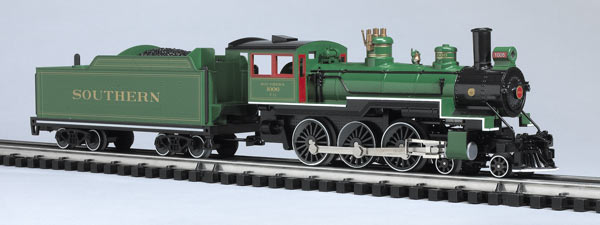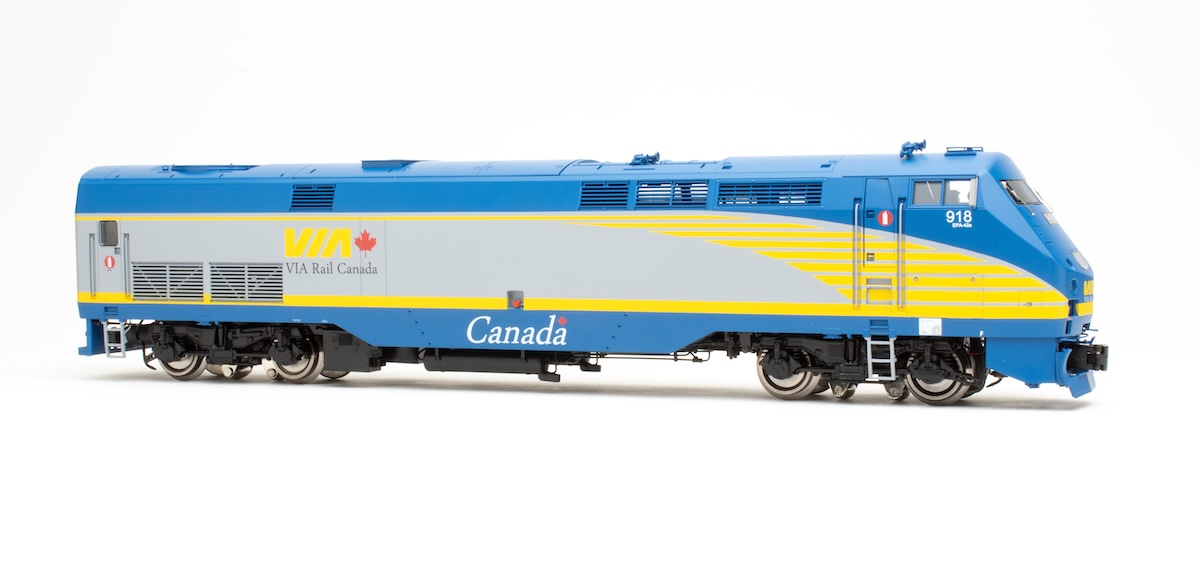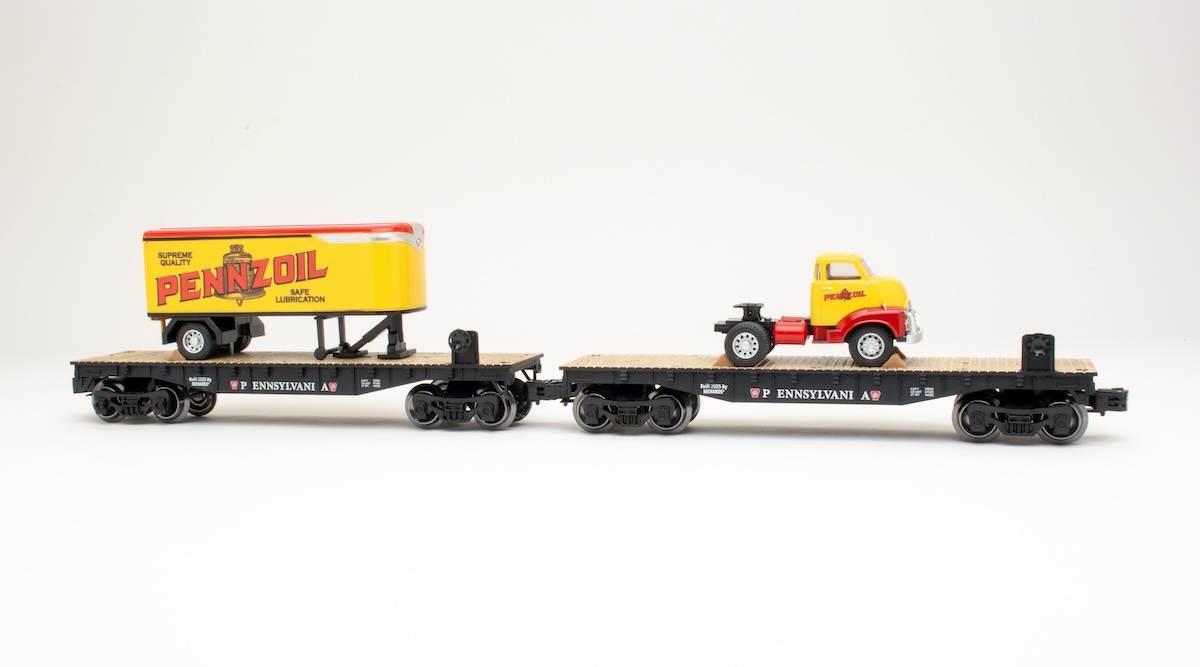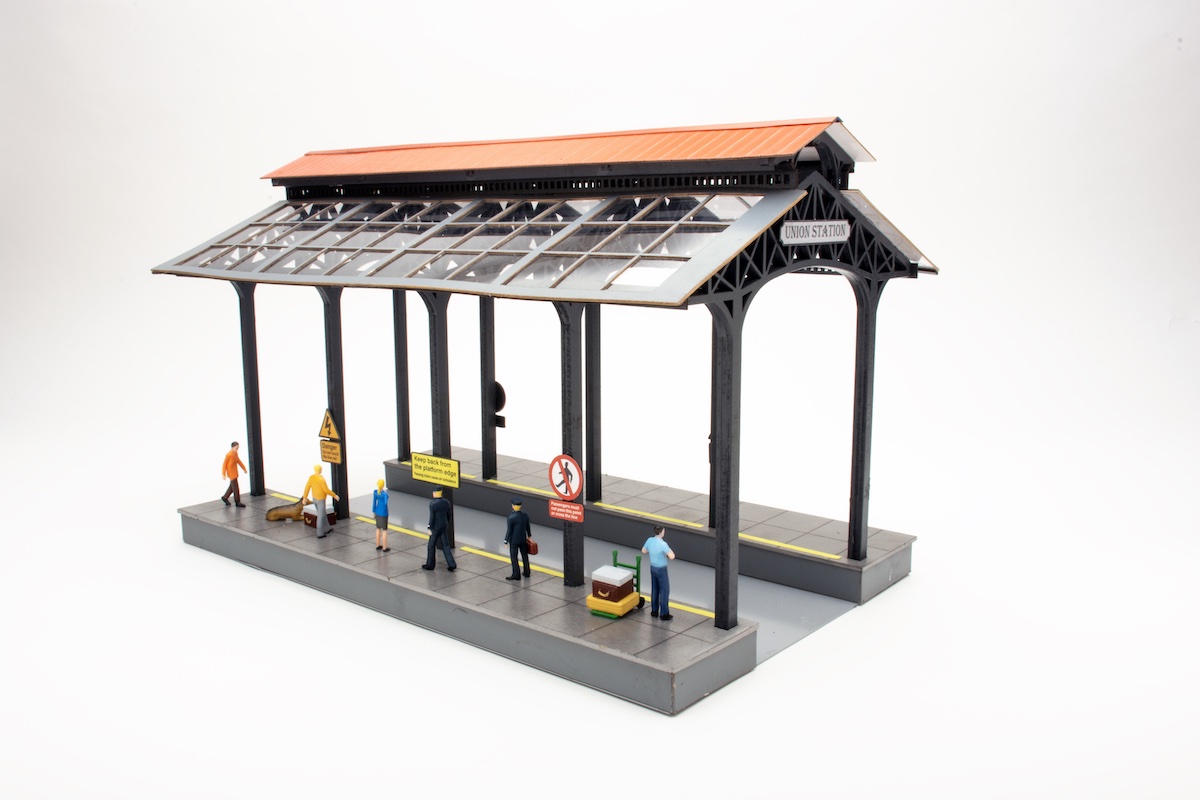This O gauge model would easily fit into a railroad theme running from, say 1890 to 1940. If you run fan trips or have an O gauge museum on your modern-themed railroad, this would work out fine as well.
Opening the box
This steam locomotive has a nice feel to it, solid, well made, and not fragile at all. The model is die-cast metal, and the design and detailing are not complex. Size-wise, it would be a contemporary steam locomotive comparable to, say, a postwar Lionel no. 2018 or no. 675.
The pilot has representations of a coupler and uncoupler arm, brakeman steps, and grab irons. There are two green jewel markers that bracket the smokebox door, which has a fair amount of cast-in details, such as rivet heads, a number plate, and a grab iron.
The top of the boiler features a headlight atop the smokebox. The smokebox has several rows of rivet detail, and there are three cast-in boiler rings. Obviously, the smoke unit is based beneath the stack.
Seek and ye shall find a Baldwin builder’s plate dated 1908 on both sides of the smokebox.
Farther back on the boiler top are steam and sand domes. There is an add-on bell, and the steam dome has a whistle and two simulated pop-off valves. You’ll find an add-on turbine topside, just ahead of the cab.
There are some cast-in grab irons and piping along both sides of the boiler that are made to look all the more impressive by some outstanding painting contrasting the black of the lines with the bright green of the Southern Ry. paint scheme.
The decks along the sides of the boiler are wide and smooth. You’ll find additional cast-in piping detail on both sides, and add-on compressors on the fireman’s side.
The cab has a simulated “raised” vent hatch (a solid element), and the cab has a nice, low firebox (yes, you can easily see down the railway line through the front cab windows).
The firebox has rivet and gauge detailing cast into it. While the cab is crewless, a number of companies make engineer and fireman figures you can easily install in this locomotive.
The cab windows have no plastic panes, but there’s a nice level of rivet detail along the cab and the windows.
The edges of the pilot and deck are trimmed in white, as are the pilot wheels and drive wheels, as well as those on the tender.
The simple side rods work for me, but some hobbyists will long for a more detailed array of moving metal.
The tender is plastic with no add-on pieces, but has ample rivet detail. However, as with some of the detailing on the metal boiler, some of the cast-in details, notably grabs irons on the front and rear of the tender and the ladder on the rear, benefit from a superbly accented paint job.
The coal load is a cast-in piece that’s nicely detailed with small-diameter coal.
The truck frames are die-cast metal and have simulated springs. The rear coupler is an operating coupler that can be triggered through a standard uncoupling track section.
Painting and decoration are excellent. The 4-6-0’s Southern Railway green is probably the most vibrant paint scheme we currently have in the CTT offices. Painting was flawless, and the decoration – ranging from white accent stripes to numbering and lettering – was amazingly clean and crisp.
On the test track
This baby is a conventional-only rig. All the action is transformer controlled. A wire tether connects the locomotive and tender at an in-jack located just below the cab deck. There is a smoke unit on/off switch beneath the fireman’s side of the cab. Interestingly, there is an empty hole in the opposite spot on the engineer’s side of the cab.
Motor operation was smooth and responsive in all speed ranges. The motor generated a bit of a whine at higher speeds, however.
The True-Blast II steam whistle has the distinctive yet familiar steam whistle grade-crossing sequence. The bell is very audible; the headlight is bright.
The model has traction tires on the rear set of drive wheels.
Our low-speed conventional-mode average was 12.6 scale mph, and our high-speed conventional-mode average was 62.9 scale mph. Drawbar pull was 1 pound, 13 ounces.
All in all, this is a nice, basic locomotive that’s fun to operate. In spite of the 1908 built date, I think this locomotive works in a number of railroad eras, and it may be just the breath of fresh (and affordable) air you are looking for.
Now, if Williams by Bachmann would just offer it in New York Central – or better yet, in undecorated black or gray!
Features: O-27 operation, die-cast metal shell, can-style motor, smoke unit, headlight, operating tender coupler, True-Blast II whistle/bell.















I heard no mention of how well the smoke unit operated if at all. I didn't see smoke.
Great Review!!!!!!!!!
Hope they bring out other road names, especialy PRR!!
Why does everything Southern have to be green?
Great value (on sale for $150.00). It is a well made that runs very well at low speeds. It pulls very well for its size. Anyone who has been frustrated by problems with more expensive electronic marvels will appreciate the trouble free operation of this conventional model. It all works . . . the smoke unit, whistle/bell and the constant lighting headlight. And it looks great too. I did notice the whine at higher speeds as mentioned in the review. However, it is not a distraction and in fact has dissipated after several hours break in. Now if Bachmann would only offer it in Long Island RR! Overall great fun!!!
Just the kind of steam loco I wish Lionel had offered "back in the day!"
I purchased the Santa Fe version (soon to be Long Island RR). Looks great, and runs great. Very good low speed operation-very smooth running through out speed ranges. I have recently given up on expensive remote control locos which seem to develope electronic problems that are beyond my expertise (and many repair shops) to repair. I have recently purchased several other conventional powered locos from Williams by Bachmann and RMT-all of which run great with no fuss. I simply let them run and smile!!!
I have had good experiences with Williams locomotives and this one seems to fit that mold: basic,smooth-running, well ma that wasde and attractively decorated. As this is a standard type of locomotive used by many rairoads, I agree that an undecorated version would be a good addition. I'll bet Williams will offer a 2-8-0 version of this one.
The crude valve gear is out of character for Bachmann. In the Baldwin 4-6-0's that they offer in other scales, complete stephenson or walschaerts valve
gears are in evidence.
Another great addition to the Williams by Bachmann assortment. I have a number of these affordable engines, and enjoy the heck out of them. I'm looking forward to adding this good looking one to my fleet!
I have one of the C&O versions of this engine, and I totally agree with your review. This engine is quite nice for the price and the craftsmen ship is top notch. This is an engine that my grandson can play with and I'll not worry about add-on pieces getting broken off. I'm running it around a loop of Gargraves 072 track with a mix of modern reefers. it is pulling elvenn cars and caboose. I think it is quite a great little engine.
This little chugger is great. I bought the C&O version for my 12 year old son and he loves it. This is saying a lot because he is normally not interested in trains and I have offered him the world. I own Century Club engines down to cheap little post war issues. He was not interested. He saw this engine and had to have it. The light is bright and the true blast whistle is a little different from some of the other Williams engines I have. For it's weight and size it is definitely the little engine that could. I found this engine for $152 at Christmas and it was a sweet deal. They aren't that cheap now. I would like to have the Southern for myself. The trick is to sneak it in before the wife bust me. Ha Ha.